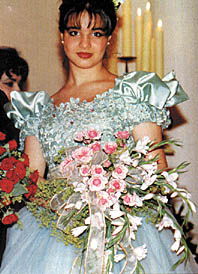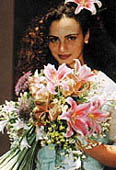
‘You are what you wear’ YEMENI WOMEN DRESSING FOR OCCASIONS [Archives:1998/31/Last Page]
August 3 1998
A long time ago, Yemeni women going to wedding ceremonies used to wear clothes of bright colors or pure white. It was inexpensive and very simple. They used to sew white clothes limited adornment or pendants.
On the party of the second day of the wedding party, women even used to put on clothes which actually had no specific colors. They were just clean, and that was all that mattered.

The change in taste has created new businesses – fashion places, dressmakers, saloons for hair-making, face make-up, and other beautification services. The registry of the Sanaa municipality alone boasts over 800 such places licensed in the city.
What happens if a woman cannot afford to buy all that fancy and costly stuff? Women who want to look their best and impress others, and yet can’t afford to buy the clothes, borrow them. This has become an acceptable and common practice, though it is also a source of lots of disputes. You have to be careful not to smear or tear a dress you borrowed.
Yemeni brides have 3 distinct gowns they must wear. There is the dress of the ‘eve of the wedding’ known as ‘Al-Ghasle’. This is usually green in color. Then there is the bridal gown itself, which is called ‘Thowb Al-Zifaf’. This is usually white. Finally, there is the gown of the day following the wedding, which is called ‘Al-Subhia’. This is often pink. The groom has to cough up the money for buying all those gowns which are worn, possibly once in a lifetime. The cost depends on the model and quality of the dress. It ranges from 10,000 to 100,000 riyals.

I asked some dressmakers about the wedding clothes, their types, and prices.
Q: What are the most sought-after types of wedding clothes and their colors?
A: They are chiffon, goober, dantella, satin. They are mostly in white color.
Q: What are the trendy models?
The best model is double cloche with a long tail. Taiz women like this model. Taiz women often leads in taste, and the nation follows.
Q: How do women choose the design or model?
A: Most women pick up a design or model from a fashion magazine, but some of them like to add their own touches to the model. They might add or omit something. If the model shows too much of the body, they often ask to change it.
Many also bring a friend’s dress and ask for a similar one, with a few alterations.
The most expensive dress, according to a dressmaker, cost YR 100,000; it is embroidered and with a long tail of about 6 meters. And the cheapest dress gown costs YR 10,000. Embroidering a dress might take 3 weeks to a few months. Some women allow the tailors to take their measurements (touch their body) but many take it at home and give it to the tailor.
Yemeni women have not totally abandoned the services of the traditional beautification methods. Women still paint on the khidhab, put on the henna, fix up the shazab and other traditional fragrances. But that is now in addition to the ‘modern’ amenities.
By: Khairiah Al-Shabiby,
Yemen Times.
——
[archive-e:31-v:1998-y:1998-d:1998-08-03-p:./1998/iss31/lastpage.htm]


